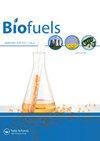Sweet sorghum and bagasse: a comprehensive review of feedstock traits, conversion processes, and economic viability for bioethanol and biogas production
IF 2.6
4区 工程技术
Q3 ENERGY & FUELS
引用次数: 0
Abstract
AbstractThis review aims to provide an extensive examination of the significance of sweet sorghum and bagasse in the context of bioethanol and biogas production. The review analyzes the available literature on sweet sorghum and bagasse as potential feedstocks for bioenergy production. It examines their physical and chemical properties, cultivation requirements, various pretreatment methods, fermentation processes, efficiency, and environmental implications. It also assesses the economic viability of and potential barriers to commercialization. Moreover, the importance of technological advancements in biomass conversion efficiency, fermentation processes, and enzymatic hydrolysis has been reviewed. The substrates’ rich cellulose and hemicellulose content enhances the efficiency of conversion processes. Remarkable advancements have been observed in fermentation techniques, with genetic engineering strategies offering potential avenues for performance enhancement. The assessment of environmental implications underscores the importance of optimizing conversion yields and energy balance to establish a sustainable bioenergy production framework. Techno-economic analyses affirm the economic feasibility of deriving bioethanol and biogas from sweet sorghum and bagasse. This thorough analysis emphasizes the substantial potential of sweet sorghum and bagasse as valuable feedstocks for bioethanol and biogas production.Keywords: Bioethanolbiogassweet sorghumbagasse Author contributionsThe author conducted a complete review process, including conceptualization; methodology; writing, review and editing; project administration; and funding acquisition.Conflicts of interest statementThe author declares that he has no conflict of interest.Data availability statementThe author confirms that the data supporting the findings of this study are available within the article.甜高粱和甘蔗渣:对生物乙醇和沼气生产的原料特性、转化过程和经济可行性的全面综述
摘要本文综述了甜高粱和甘蔗渣在生物乙醇和沼气生产中的重要意义。本文分析了甜高粱和甘蔗渣作为生物能源生产潜在原料的现有文献。它检查了它们的物理和化学性质,培养要求,各种预处理方法,发酵过程,效率和环境影响。它还评估了商业化的经济可行性和潜在障碍。此外,对生物质转化效率、发酵过程和酶解技术进步的重要性进行了综述。底物丰富的纤维素和半纤维素含量提高了转化过程的效率。发酵技术取得了显著的进步,基因工程策略为提高性能提供了潜在的途径。对环境影响的评估强调了优化转化产量和能源平衡以建立可持续生物能源生产框架的重要性。技术经济分析证实了从甜高粱和甘蔗渣中提取生物乙醇和沼气的经济可行性。这项深入的分析强调了甜高粱和甘蔗渣作为生物乙醇和沼气生产的宝贵原料的巨大潜力。关键词:生物乙醇沼气甜高粱甘蔗渣作者贡献作者进行了完整的综述过程,包括概念化;方法;写作、审阅、编辑;项目管理;以及资金获取。利益冲突声明作者声明他没有利益冲突。数据可用性声明作者确认在文章中可以获得支持本研究结果的数据。
本文章由计算机程序翻译,如有差异,请以英文原文为准。
求助全文
约1分钟内获得全文
求助全文
来源期刊

Biofuels-Uk
Energy-Renewable Energy, Sustainability and the Environment
CiteScore
5.40
自引率
9.50%
发文量
56
期刊介绍:
Current energy systems need a vast transformation to meet the key demands of the 21st century: reduced environmental impact, economic viability and efficiency. An essential part of this energy revolution is bioenergy.
The movement towards widespread implementation of first generation biofuels is still in its infancy, requiring continued evaluation and improvement to be fully realised. Problems with current bioenergy strategies, for example competition over land use for food crops, do not yet have satisfactory solutions. The second generation of biofuels, based around cellulosic ethanol, are now in development and are opening up new possibilities for future energy generation. Recent advances in genetics have pioneered research into designer fuels and sources such as algae have been revealed as untapped bioenergy resources.
As global energy requirements change and grow, it is crucial that all aspects of the bioenergy production process are streamlined and improved, from the design of more efficient biorefineries to research into biohydrogen as an energy carrier. Current energy infrastructures need to be adapted and changed to fulfil the promises of biomass for power generation.
Biofuels provides a forum for all stakeholders in the bioenergy sector, featuring review articles, original research, commentaries, news, research and development spotlights, interviews with key opinion leaders and much more, with a view to establishing an international community of bioenergy communication.
As biofuel research continues at an unprecedented rate, the development of new feedstocks and improvements in bioenergy production processes provide the key to the transformation of biomass into a global energy resource. With the twin threats of climate change and depleted fossil fuel reserves looming, it is vitally important that research communities are mobilized to fully realize the potential of bioenergy.
 求助内容:
求助内容: 应助结果提醒方式:
应助结果提醒方式:


